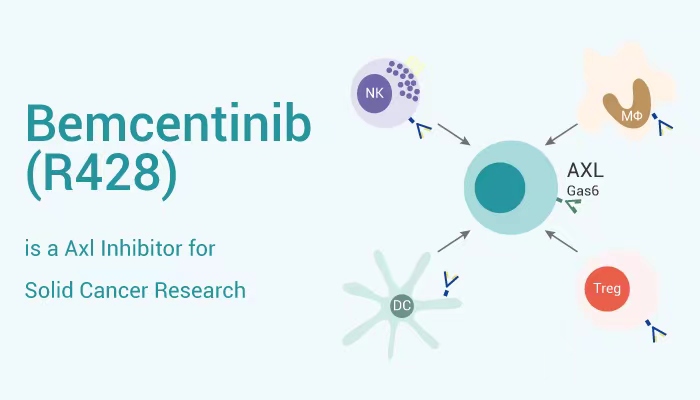Axl is a member of the TAM (Tyro3, Axl, Mer) receptor tyrosine kinase (RTK) family. Particularly, Axl involves in the stimulation of cell proliferation and survival. Besides, Axl signaling stimulates cellular responses, including activation of phosphoinositide 3-kinase-Akt, ERK, NF-κB pathway, and STAT signaling. Importantly, Axl is an inhibitor of the innate immune response. Moreover, AXL is a putative driver of diverse cellular processes that are critical for the development, growth, and spread of tumors, including proliferation, invasiveness and migration, epithelial-to-mesenchymal transition, stemness, angiogenesis, and immune modulation.
In this article, we will introduce an Axl inhibitor, Bemcentinib.

Bemcentinib (R428) (0-5 µM; HeLa cells) inhibits Axl kinase activity with IC50 values of 14 nM. Besides, Bemcentinib (0-1.11 µM; 1 h) potently blocks autophosphorylation on COOH-terminal multiple docking sites, Tyr821, stimulated by either antibody-mediated cross-linking or Gas6. Moreover, Bemcentinib (0.03, 0.3, 3 µM; 3+16, 24 h) dose-dependent inhibits invasion in MDA-MB-231 and murine 4T1 cells.
Bemcentinib also shows anticancer activity in mice. Such as, Bemcentinib (25, 75 mg/kg; p.o.; once) in female BALB/c mice shows a long plasma half-life (4 hours at 25 mg/kg; 13 hours at 75 mg/kg) and distributes effectively to tissues. Besides, Bemcentinib (125 mg/kg; p.o.; Twice-daily for 24 days) significantly blocks MDA-MB-231-luc-D3H2LN metastases development in two independent mouse models of breast cancer dissemination, suppresses both tumor angiogenesis and vascular endothelial growth factor (VEGF)-induced corneal neovascularization in vivo. Moreover, Bemcentinib (R428) (75 mg/kg/day, 25 mg/kg twice daily, p.o.) makes mice keep on a high-fat diet resulting in significantly reduced weight gain and subcutaneous and gonadal fat mass.
All in all, Bemcentinib is an orally bioavailable, potent, and selective Axl inhibitor. Bemcentinib has the potential for the research of metastatic breast cancer.
Reference:
[1] Holland SJ, et al. Cancer Res. 2010 Feb 15;70(4):1544-54.
[2] Lijnen HR, et al. J Pharmacol Exp Ther. 2011 May;337(2):457-64.